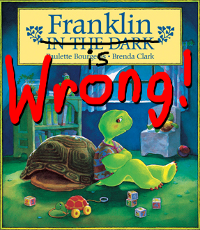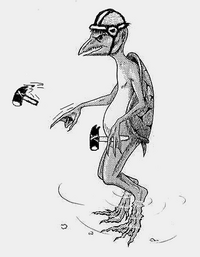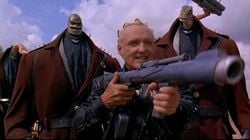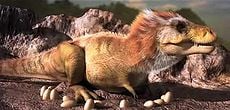The 'Shroom:Issue 64/Theoretical Macroevolution of Koopas: Difference between revisions
(Created page with "__NOEDITSECTION__ __NOTOC__ <noinclude><div class="shroomsupermario64"></noinclude><div class="right"><h2 style="font-family:Kunstler Script;font-size:350%;color:black">Theore...") |
mNo edit summary |
||
| Line 7: | Line 7: | ||
==Everything You Know is Wrong== | ==Everything You Know is Wrong== | ||
[[File: | [[File:Nofranklin.png|thumb|left|200px|Children's literature: making herpetologists everywhere weep.]] | ||
First of all, Koopas are not turtles. And I don't mean that in the "well, they live on land so they're more like tortoises" sense - I mean it in the "there is no possible way these guys are or evolved from turtles" sense. Why? Well, the most obvious difference is that various Koopa species can remove their shells and still function, whereas a turtle shell includes both its spine and ribs, all fused together with a set of bony dermal plates. If Koopa shells were turtle shells, then de-shelling a Koopa would be akin to pulling someone out of their own ribcage. This would not end well. One ''could'' argue that the turtles that gave rise to the Koopas could have evolved so that their vertebrae and ribs are free-floating again, while the dermal plates remain, but you don't evolve that degree of specialization and then go back. Yes, in evolution, certain traits are gained and lost and regained sometimes, but not to this extent, especially when you consider all the other unique aspects of turtle physiology. Even their breathing is specialized: since they can't move their ribs anymore, they use their throat, gut muscles and even the muscles attached to their legs as a set of bellows to pump air in and out. Koopas don't do this: as you can see in many of the RPG sprites, Bowser and the other Koopas inhale and exhale like the rest of us. | First of all, Koopas are not turtles. And I don't mean that in the "well, they live on land so they're more like tortoises" sense - I mean it in the "there is no possible way these guys are or evolved from turtles" sense. Why? Well, the most obvious difference is that various Koopa species can remove their shells and still function, whereas a turtle shell includes both its spine and ribs, all fused together with a set of bony dermal plates. If Koopa shells were turtle shells, then de-shelling a Koopa would be akin to pulling someone out of their own ribcage. This would not end well. One ''could'' argue that the turtles that gave rise to the Koopas could have evolved so that their vertebrae and ribs are free-floating again, while the dermal plates remain, but you don't evolve that degree of specialization and then go back. Yes, in evolution, certain traits are gained and lost and regained sometimes, but not to this extent, especially when you consider all the other unique aspects of turtle physiology. Even their breathing is specialized: since they can't move their ribs anymore, they use their throat, gut muscles and even the muscles attached to their legs as a set of bellows to pump air in and out. Koopas don't do this: as you can see in many of the RPG sprites, Bowser and the other Koopas inhale and exhale like the rest of us. | ||
Revision as of 12:26, July 21, 2012
One of the things I've always loved about the Mario series is how it leaves so much to the imagination. You can spend endless hours trying to reconcile all the conflicting information presented to us by creators who obviously don't think a happy-go-lucky series like Mario needs to bother with consistency, but to me, that sort of problem solving is just as fun as the games themselves. Yeah, I know, I'm weird - and it gets weirder. While I started out simply wanting to mash all the games and their worlds together into one timeline and one master map, my real passion isn't history or cartography: it's science. At first, you wouldn't think that science has much business with games based on a portly plumber who eats mushrooms to grow giant, shoots fireballs from his hands, and jumps three times his height (when he's not simply using a raccoon tail to fly), but hey, in the Mushroom Kingdom, who says you can't have magic and science?
My favourite branch of science is zoology, which lends itself quite handily to the vast array of species found in the Mario series. In particular, I focus on the Koopas - their diversity is fascinating, especially if you think outside the box and include Clubbas, Spinies and Buzzy Beetles. It's always made me wonder how they're related, and by extension, how they evolved - and from what. Of course, taxonomy is considered to be one of the drearier breeds of biology even amongst zoologists, so rather than bore you all with a detailed analysis of the Koopa family tree, I've decided to stick with the macroevolutonary half of the equation and do a quick overview of where I think Koopas in general came from. But don't let the jargon scare you off: macroevolution is the least nitty-gritty of all the evolutionary subjects (in my opinion), and I'm not about to bring stuff like gene flow, allopatric speciation or the Red Queen into a discussion about Mario. Just some good old speculation about the enemies we know and love.
Everything You Know is Wrong
First of all, Koopas are not turtles. And I don't mean that in the "well, they live on land so they're more like tortoises" sense - I mean it in the "there is no possible way these guys are or evolved from turtles" sense. Why? Well, the most obvious difference is that various Koopa species can remove their shells and still function, whereas a turtle shell includes both its spine and ribs, all fused together with a set of bony dermal plates. If Koopa shells were turtle shells, then de-shelling a Koopa would be akin to pulling someone out of their own ribcage. This would not end well. One could argue that the turtles that gave rise to the Koopas could have evolved so that their vertebrae and ribs are free-floating again, while the dermal plates remain, but you don't evolve that degree of specialization and then go back. Yes, in evolution, certain traits are gained and lost and regained sometimes, but not to this extent, especially when you consider all the other unique aspects of turtle physiology. Even their breathing is specialized: since they can't move their ribs anymore, they use their throat, gut muscles and even the muscles attached to their legs as a set of bellows to pump air in and out. Koopas don't do this: as you can see in many of the RPG sprites, Bowser and the other Koopas inhale and exhale like the rest of us.
But wait, you say: the games are always calling the Koopas "turtles", and messy biology aside, they do look pretty similar. Two words: convergent evolution. Plenty of things evolve to look similar, for example, glass lizards may be legless reptiles, but they're not snakes; harmless hoverflies purposefully evolved to look like stinger-bearing bees and wasps; and Glyptodon looks a lot like a turtle too, but it's actually an ancient relative of the armadillos. Given the benefits of a shell, it's no wonder they've popped up multiple times in both real life and the Mushroom World. And as for the "turtle" stuff, there's lots of completely unrelated animals being called the same thing in real life. European Blackbirds aren't related to American blackbirds, but to American Robins, which, in turn, aren't related to European Robins at all - those are a kind of Old World flycatcher (not to be confused with the flycatchers you get in North America, of course). And earthworms, tapeworms and ribbon worms are all long, limbless "worms", but we're more closely related to fish than they are to each other. With real life science that screwy, it's not surprising that the fictional characters have trouble with their nomenclature too.
Koopa Creation
Okay, so Koopas aren't turtles - but then what are they? Well, first of all you need to identify the first Koopa and work backwards from there. Most people assume that Shellcreepers were the first Koopas since they, well, came first, but I disagree. The main issue is the old removable shell problem we see in both Shellcreepers and the next, better-known evolutionary step: the Koopa Troopas (the four-legged kind, not the two-legged ones - which are a different species, even though they're called the same thing in the games, but I digress). You think turtle shells are specialized? Detachable Koopa shells are ten times crazier: that kinda thing would take time to evolve - there's no way Koopas started out with 'em. It'd also be a lot harder to go from a quadrupedal lifestyle to bipedalism when you've got a heavy shell pushing down on you, whereas it's a lot more understandable if certain two-legged Koopas dropped to all fours from time to time. Plus there's the fact that, shells aside, Koopa Troopas are pretty plain, whereas the other species have a myriad of special powers, from firebreath to walking on the ceiling and everything in between. Yeah, all those could have evolved multiple times, and I certainly can't make a perfect Koopa family tree without some powers appearing and disappearing, but it's still more plausible if the common ancestor of the Koopas had the skills right from the start, and they just wound up dormant in different descendents.

And that brings us to the most powerful Koopa of 'em all: Bowser. He has firebreath, lighting and teleportation powers, shockwave-inducing Ground Pounds, a poisonous bite, black magic, and the ability to pull massive amounts of hammers out of nowhere - and that's not even including his variable size and other extra powers given to him by objects like the Grand Star, his transformative abilities in the anime movie, or the fact that he can have all his flesh burned off by lava and come back for more. If you consider his kids too, you can add Flutter Jumping, limb-stretching, Sonic Roars, both high-speed spinning and double team-like attacks, and the ability to climb vertical walls and walk on the ceiling to the list of mad skills. Not too shabby for a species Nintendo hasn't even officially named yet. It's also pretty representative of what Koopas as a whole are capable of, minus a couple things like changing colours, turning invisible, pulling spiked balls out of your mouth, or swapping your arms for wings, but like the removable shell stuff, those kind of specializations would have come later. And, while some games imply that Bowser's own shell is removable, the only time we actually see this is in the MS-DOS version of Mario is Missing! - but that also had the tail being green and part of the shell, and even though it only covered Bowser's back, taking it off miraculously made boxer shorts appear in front too, and really, this is the game that brought us Weegee, so how much faith are we seriously going to put in its science?
Personally, I say shell-removing doesn't happen until we get down to the Koopa Troopas, with the Strikers being early examples. I've got a whole complex theory about how the shell removal arose, but I'll make this as fast as possible... Basically, the neural spines of the vertebrae extended upwards and fused with bony plates on the skin (think Spinosaurus meets Ankylosaurus), and similar plating eventually curved back down around the body forming the plastron part of the shell. The hollow between that plates and the ribcage became a reservoir for hammerspace energy, with the bony connection with the spine and all the fleshy bits receding, until eventually the only connection is energy itself. The Strikers can break it momentarily to throw their shell and materialize a new one, and Koopa Troopas have gotten to the point where their energy can recede inside their body, allowing them to exist without one indefinitely. The shell stuff isn't the only change that happens, of course, but as I said earlier, this article isn't about the evolution within the Koopa family - all you really need to take away from all this is that something like Bowser was the first "Koopa".
Beta Bowser?
With that finally out of the way, we move on to the question of where Bowser's species came from. Bowser himself was actually inspired by an anime ox character, and his shell was only added later on in development because one of the developers realized it made little sense to have a cow as the turtle king. And back then they were a lot more turtley: not including the non-Koopa Troop Shellcreepers from Mario Bros., de-shelling wasn't introduced until Super Mario World, and the Super Mario Bros. Koopa Troopas were still four-legged as far as the sprites went. The Hammer Bros. were bipeds, however, and unlike their cousins, sported bird-like beaks (and duck-like feet), which might have been because Shellcreepers originally had beaks, but might also be a reference to another fictional, beaked, shelled biped: the Kappa.
Lots of Mario fans assume that the Kappas were the inspiration for the Koopa name, but in Japan, the turtle soldiers and their kingdom aren't called "Koopas" at all: only the king goes by that, having been named after a kind of Korean soup. (As an aside, his English name origin is a lot less concrete. One theory is that he's named after Jon "Bowzer" Bauman of the rock band Sha Na Na, like how the Koopalings were later named after musicians, but I prefer the hypothesis is that it comes from a kind of fuel tanker - large, round and potentially fiery, just like the Koopa King.) Soup is even more useless to us than the Shellcreeper stuff as far as trying to build on real life development goes, but while both the design inspirations and etymology of the Koopas prove to be a dead-end, the Kappa connection is going in the right direction: we're just barking up the wrong myth.
Here There be Dragons
At least one add for Super Mario Bros. spoke of "conquering dragons", and y'know what? It was right. Aside from that, nothing official calls him a dragon, but he does breathe fire. Not convinced yet? Then I direct your attention to the Koopa that's not a Koopa: Yoshi. Yes, as evidenced by that shell on his back (I'm sorry, but saddles are not grown, and they are not dome-shaped), Yoshi was originally envisioned as a kind of benevolent Koopa, and he also has a few draconian traits too (most noticeably in his Super Dragon Final Smash). I'm not saying Yoshis are long-lost Koopas, but I do think they're at least a distant cousin, and while I won't argue against Yoshi being a dinosaur, I challenge the notion some people have that he can't be a dragon too (making Koopas a member of both classifications as well). In real life, dinosaur fossils were confused for dragon bones at least a couple times, and now they're naming all sorts of those new Chinese dinos after dragons (and also this guy, the "Dragon King of Hogwarts"). Of course, scientists know better than to get the two confused, but when you're looking at fictional dinosaurs, many of whom breathe fire (i.e. Yoshis, Birdos, Dino-Torches and Reznors), the fact that the lines are getting blurry is quite understandable.
So we've now established that Shellcreepers weren't the first Koopas, Bowser's species was, and they didn't come from turtles, they came from dragons, which in turn are a kind of dinosaur. But which dinosaur? Given the vast diversity of Mario dragons (including Koopas, Yoshis and other dragonish dinos), there's no way they came from any one dinosaur. Firebreath and flight are cheap in the Mushroom World: convergent evolution involving those powers happens all across the board, so it's more likely that different dinos developed dragon tendencies than one firebreathing breed giving rise to everything from Rexes to Blarggs to the TTYD 'Tail family. Unfortunately, this is when the solid information dries up: there are no dragons or even dinosaurs in the Mario games that remotely resemble Bowser and the Koopas. But macroevolutionary biologists are no strangers to big gaping holes in the fossil record - there are ways around them, and our way is a movie most people wish never saw the light of day: the Super Mario Bros. live action film.
The Lizard King
The idea that dinosaurs could evolve into things that look exactly like humans is totally unrealistic, but at least this movie gives us some official material to back up the Koopas-are-dinosaurs idea. It also gives us an ancestor for ol' Koopa: the "lizard king" himself, Tyrannosaurus rex. Too bad that doesn't actually work - and for reasons similar to the turtle problem. T. rex may not have developed a highly specialized carapace and a unique internal organ design to go with it, but by the time this species arose, the forelimbs of its line had degenerated pretty severely. Its arms were pretty strong, but they were also inflexible and teeny compared to the overall body size, and it's unlikely that the two-fingered hand could give rise to the human-like Koopa limbs: once you lose a toe, you don't typically grow it back with new and improved opposable action. So, while T. rex is a good starting point, for the Koopa ancestor, we need to go back further.
Of course, this is easier said than done, since there's a bit of a Catch-22 in the Tyrannosaur family: the higher up you get, the more fingers you find, but the dinosaurs get smaller too. But all is not lost: the theropods were a diverse bunch, and while we have to jump ship completely from the Tyrannosaur line, other families have plenty of promising possibilities. Allosaurus is probably the quickest option to come to mind, since it's basically a slightly smaller cousin of T. rex with longer arms - but only three fingers. Another family gives us Acrocanthosaurus, which is large and sports robust limbs, plus, its neural spines are already elongating, but once again, only three fingers. And then there's Ceratosaurus: it's not overly large, its neural spines aren't particularly tall, and its forelimbs are short, if muscular, but it does have four fingers, and the bony deposits in the skin running down its back could be the precursor to the armour plating that becomes Koopa shells, while the weird lumps on its head just need to move around a bit to give you the start of Bowser's oxen horns.
Admittedly, while it's the closest match I've found so far, Ceratosaurus is far from perfect. There have been plenty of times I've even considered scrapping the four-finger limitation and simply saying the Koopa ancestor had three fingers and regained a fourth as its thumb (polydactyly is a pretty well-documented mutation, after all - just ask Inigo Montoya). That'd certainly make the search a lot easier, but then again, where's the fun in cutting corners? I've loved dinosaurs even longer than Mario and could spend hours digging through Wikipedia for new species - it is a bit frustrating when you realize a perfect Koopa ancestor is actually an artist's impression and the only fossils they have of it are a couple leg bones, but that could easily change by the next read-through as more and more fossils are unearthed, expanding our knowledge and forever changing how we think of these ancient creatures. The discovery of Yutyrannus earlier this year, was a game-changer, for example, not only because its large size and three-fingered hands were unheard of in the Tyrannosaur line (as I mentioned earlier), but because the thing's covered in feathers from head to toe. Now scientists are wondering if Tyrannosaurus rex was also a big fuzzball, thereby ruining the mental images of children's favourite man-eating monster forever - and also providing a possible origin for Koopa hair, if I may play devil's advocate here. (And while we're at it, how 'bout them feathery Paratroopa wings?)
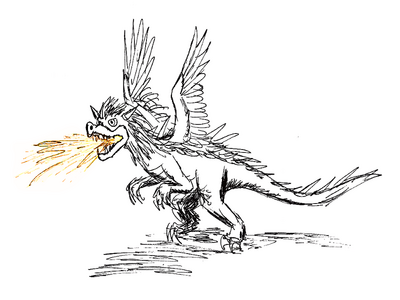
So who knows - with new species being discovered all the time, maybe the perfect Koopa ancestor simply hasn't been dug up yet. And with Nintendo still churning out new Mario games, there will always be a supply of new Koopas to add further down the evolutionary line too. Macroevolution may be a real life field of study, but as you can see, it can be applied to both real and fictional dinosaurs alike. I certainly find both halves of the equation to be quite engrossing, and while I doubt anyone's quite at my level of weirdness, I hope I at least gave you some idea of how interesting this stuff can be - whether it's solving a paleontological puzzle, or a pixelated one.
